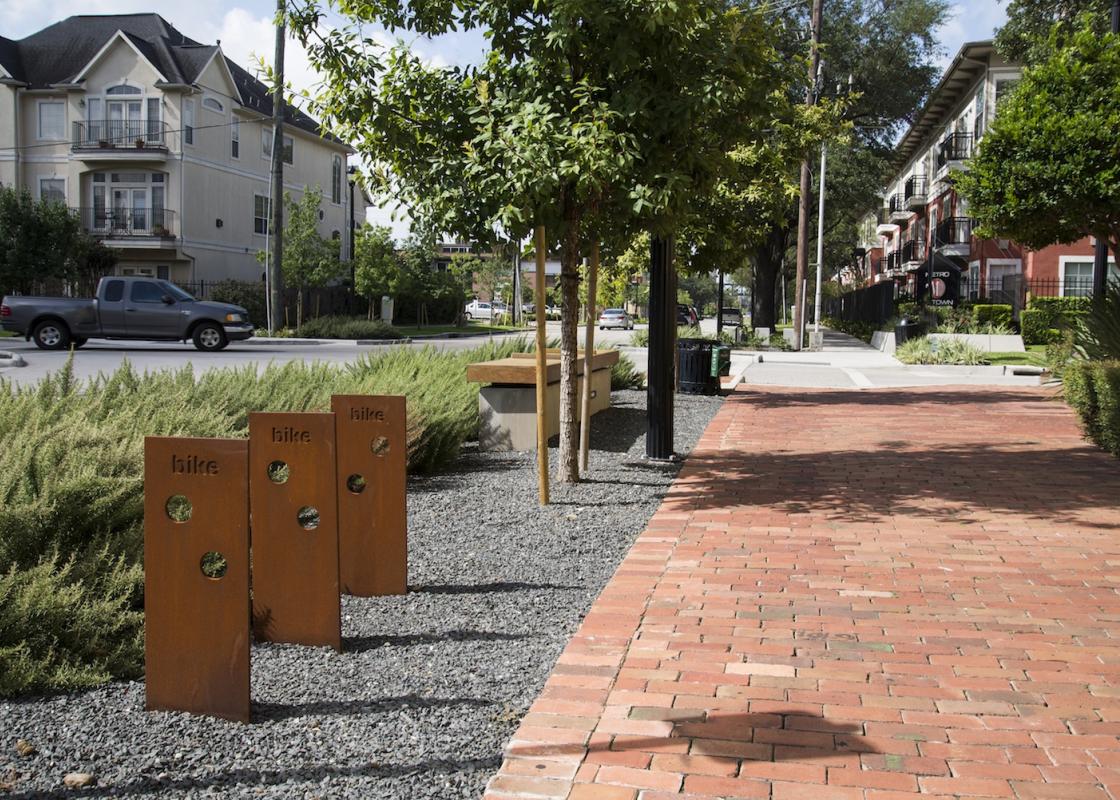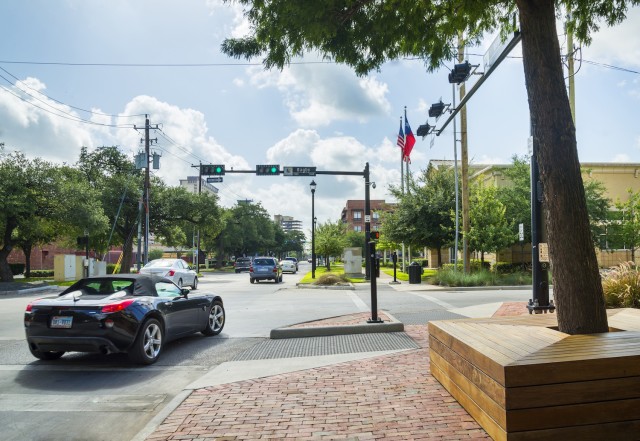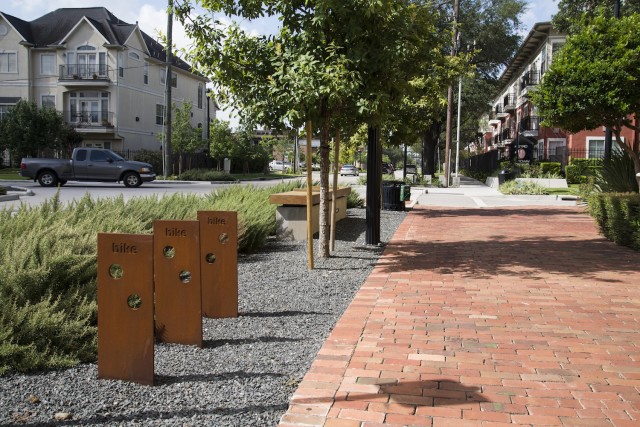Almost a year ago, on November 1, 2013, Mayor Annise Parker signed her Complete Streets Executive Order calling on City employees to do all they can to make all streets safe for all users, regardless of age, ability, or mode of transport. Though a single proclamation cannot change a city overnight, a rapid transformation is possible because of ReBuild Houston, the multibillion dollar road-building and drainage initiative created by the 2010 Proposition 1 vote.
The Design
What would Complete Streets look like in Houston? One pilot project to consider is in Midtown --- Bagby Street between I-45 and the Spur. The Midtown Redevelopment Authority asked Design Workshop out of Austin to redesign the street to take better consideration of pedestrians while using various environmentally sound principles to reduce the negative impact of street construction and improve water quality. You really should walk down Bagby. Notice the bulbouts --- curb extensions that allow for a shorter pedestrian crossing. Notice simple design elements that respect the pedestrian, such as benches for resting or for sitting and enjoying the space. Notice how investments in good streets can also serve water quality.
Though a good start, Bagby Street is not a full example of what the city can accomplish if appropriate departments actually pursue Complete Streets. It remains an unsafe place for people on bicycles with unnecessarily wide lanes and no treatment for bicyclists. The northern part remains an unsafe place for pedestrians, due to the same excessive lane width, a lack of safe crossings, a speed-focused design for cars, and nothing to signal drivers to adjust from exiting a freeway to integrating into a walkable urban environment.
Some of the missing elements were in the original Design Workshop proposal --- most importantly a safe, separated bike lane and additional bulbouts for pedestrian crossings and traffic calming --- but were dropped because they conflicted with the current Infrastructure Design Manual (IDM), Major Thoroughfare and Freeway Plan, and Bicycle Master Plan. As we put projects on the ground, city departments and commissions will need to change the IDM and other rules and procedures to allow for safer streets.
The Process
Perhaps more important than a new vocabulary of street design are changes in community processes. Every ReBuild Houston project follows a process. The Planning Commission decides every year how many lanes we hope to provide for cars on our streets. Every CIP project has public meetings. These should become more relevant as we adopt a Complete Streets approach, because the context, needs, and dreams of the neighborhood hold more weight in this world than in our previous speed-focused road design paradigm.
Mayor Parker’s executive order requires a Complete Streets and Transportation Plan that incorporates the existing bundle of plans we already have: the Major Thoroughfare and Freeway Plan, the Bikeway/Pedestrian Plan, the Transit Plan, the Rail Plan, the Multimodal Classification Plan, Context Report, and the Master Parking Plan. The coordination of all these plans is a daunting task in a city that vaunts its lack of traditional planning. However, with Mayor Parker’s recent appointment of Pat Walsh as the new Planning and Development Director and Dale Rudick as the new Director of the Public Works and Engineering Department, it’s possible Houston is poised to implement a Complete Streets approach.
The Scope
This is not a story about a handful of little projects in affluent areas. Complete Streets fits the diversity of Houston with appropriate, efficient infrastructure and optimization of our limited transportation funds for all Houstonians. For example, Houston Tomorrow is currently working with the diverse areas of OST/South Union, Near Northside, Neartown, and Washington Ave/Super Neighborhood 22 on pilot proposals for Neighborhood Greenways, which can quickly spread the benefits of Complete Streets across the City.
In Portland, “Neighborhood Greenways create a trail-like experience on streets that already don't have a lot of car traffic by adding bulbouts, small roundabouts, speed bumps, street trees, and other simple design elements,” according to Greg Raisman with the Portland Department of Transportation. In Seattle, two Neighborhood Greenways streets have seen 635 and 805 percent increases in bicycle ridership. In this Complete Streets approach, we can do a lot with a little by deploying a grid network of safe neighborhood treatments on existing local streets.
In the long run, we will begin to see every single project in every neighborhood use the design principles of Complete Streets. If truly implemented, Complete Streets will come to River Oaks and Sunnyside, Kingwood and Montrose, Downtown and the Energy Corridor, Gulfton and Sharpstown. Every street in Houston is used by humans worthy of safe and comfortable infrastructure.
The children of Houston should enjoy the freedom of riding their bikes around town. The elderly and disabled of Houston should enjoy the freedom of continued access to the good life without a car. All of us should expect our elected officials and public servants to make real progress on reducing the unnecessarily high rates of traffic deaths we currently suffer --- in our cars, on foot, or on a bike.
We can and should build a city more comfortable and safer for our people. We don’t have to look afar for inspiration. Historically, we were a transit-oriented and walkable urban city. Walk down Fairview and imagine a streetcar and a street filled with pedestrians and thriving small businesses. That is Houston’s heritage, and we can build it again.
If you are interested in walkable communities, come to the Rice Design Alliance WALK HOUSTON civic forum this evening at the Brown Auditorium, The Museum of Fine Arts, Houston, 1001 Bissonnet Street at 6:30 pm.












